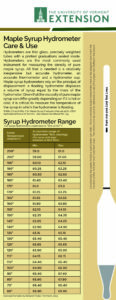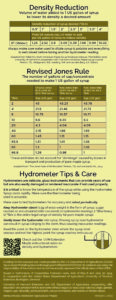Temperature Compensation Chart for Maple Syrup Hydrometers
The University of Vermont Extension’s “New” temperature compensation chart syrup hydrometers. 


Showing 1 – 10 of 63 resources
The University of Vermont Extension’s “New” temperature compensation chart syrup hydrometers. 


New Temperature Compensation Chart for Syrup Hydrometers developed by the University of Vermont Extension
Business is booming if you own a commercial sugar bush! As forest managers, this means more and more of us are hearing from landowners interested in starting or maintaining a sugar bush. Unfortunately, if you are like us, you did not learn about maple syrup in forestry school. This episode’s guest, Mark Isselhardt, Extension Maple Specialist with the University of Vermont, helps us unpack the fundamentals of sap production, sugar bush management, and how the industry has changed in the 21st century.
Guidelines for tapping maple trees have existed for well over 100 years. Early tapping guidelines came about when buckets (gravity collection) were the only technology available for harvesting sap. New tapping guidelines are based on years of research into maple tree growth, sap harvesting practices/technology and a recognition that tree diameter alone does not fully explain all the factors that determine if tapping intensity in a given sugarbush is sustainable. This fact sheet presents sustainable tapping guidelines.
This research is focused on a first of its kind survey of professional foresters with the goal of not only understanding the technical approaches foresters use when working in sugarbushes, but also how the surveyed foresters view sugarbush management compared to managing stands for other forest products.
According to a recent survey of more than 300 maple producers in the northeast United States, nonconductive wood was hit during tapping on average 4.5% of the time and the responses ranged from 0-41% of the time (UVM Extension 2019 unpublished). Previous research has explored factors that impact the likelihood of tapping into NCW. Significant factors include but are not limited to; dropline length, taphole diameter, tapping intensity (number of taps/tree) and stem growth (van den Berg and Perkins 2014). Other work touched on the relationship between the amount of conductive wood exposed while tapping and yields (Wilmot et al. 2007). But to date, there has been no direct investigation as to the relationship between the percent of NCW is intercepted while tapping and sap yield. The present study sought to understand the relationship between the amount of NCW in a given tap how and the amount of sap collected, as well as understanding if other factors (sap sweetness) might impact total yields between treatments.
These handy cards provide checklists for color, clarity, density, and flavor, with notes on why syrup may not measure up to standards.
Maple production requires sugarmakers possess a diverse set of skills in order to tend the forest resource and maintain a productive sap collection system. Maintaining a healthy, diverse sugarbush that maximizes its growth potential requires periodic vegetation management activity. Also known as thinning, vegetation management is the process of reducing competition for light, water and nutrients of crop trees. Felling trees is the key activity in vegetation management and may be done by logging professionals in support of formal forest management plan objectives or by the sugarmaker or landowner on an as needed basis and including response to extreme weather events.
Tips for building a homemade reverse osmisis machine.
How does a tree respond to the wound created by a taphole, and what does that mean for future sap production?